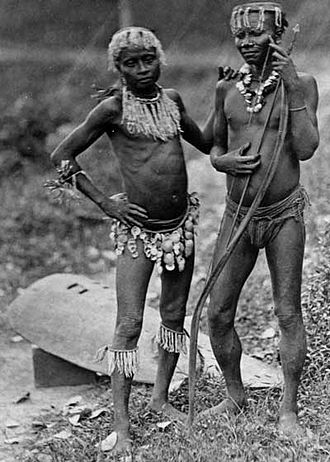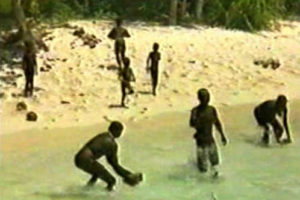Asian Tsunami: Lessons from the Survivors: Why more than 200000 people perished and most of the primitive tribes survived?

The devastating tsunami that struck several nations around the Bay of Bengal and the Indian Ocean on the 26th of December, 2004 killed more than 2,00,000 people and caused horrific destruction to property. While the media reported many stories of heroic survivors who floated on the sea for days, there were many others who quietly survived the disaster, apparently running to safety even before the tsunami struck the coastline. These included the primitive tribes of Andaman and Nicobar Islands of India and animals across the region.
When the tsunami, caused by an underwater earthquake off the large island of Sumatra, struck 13 coastal nations around the Indian Ocean on December 26, 2004, it was feared that the dwindling ancient tribes of the Andaman and Nicobar islands would have perished, unable to defend themselves against the huge waves. But as the days passed, it became clear that these people have managed to survive without much loss among their numbers. What made these people save themselves despite the fact that their homelands in the Andaman Sea were among the hardest hit of all the areas affected by the catastrophe (being very close to the epicentre of the earthquake) while hundreds of more modern people died even at much farther locations? Did they survive the tsunami with Stone Age instincts?
The Andaman and Nicobar Islands comprise of more than 500 islands across a 8,300-square-kilometre chain in the southern reaches of the Bay of Bengal. Even one of the earliest visitors, Marco Polo, called the atolls “the land of the head hunters.” Roman geographer Claudius Ptolemaeus called the Andamans the “islands of the cannibals.” The population of the islands is estimated at 350,000, living on 30-to-40 of the islands. The tribal population makes up just under 10 percent, or about 30,000. The largest group are the Nicobaris, who number 26,000. The five other tribes of Mongoloid and African origin, who were the first inhabitants of the islands and surviving on hunting and gathering, have only 400 to 1,000 members alive today with their numbers steadily dwindling over the past several decades. They are nomadic hunter-gatherers who live in the forest and fish in coastal waters and not yet reached the agricultural level of development. Despite their apparently common continental origin and geographical proximity, the languages of the four tribes are mutually unintelligible.

The Nicobarese constitute more than 98% (>26,000) of the tribal population and are settled in the Car Nicobar Island, Nancowry group of islands and in Harminder Bay of Little Andaman. The primitive tribes Great Andamanese (numbering only 43) live in Strait Island, the Onges (100) in reserves in Dugong Creek and South Bay in the Little Andamans, the Jarawas (350) in the jungles of the South and Middle Andaman Islands, the fiercely independent Sentinelese (250) in the North Sentinel island and the Shompens (250) deep in the jungles of Great Nicobar Island. Anthropological DNA studies have indicated that these tribes may have a history of 70,000 years, having originated in Africa and migrated to India through Indonesia. The tribes have the most ancient (Paleolithic), nomadic lifestyle known to man.

Many produce fire by rubbing stones; survive by hunting with bows and arrows, by fishing in the sea and gathering roots and fruit and live in leaf-and-straw community huts. This life-style makes them self-sufficient and independent. They do not have any contact with the ‘modern world’ and don’t take kindly to intrusions. The Sentinelese are fiercely protective of their coral reef-ringed terrain. They used to shoot arrows at government officials when they came ashore and offered gifts of coconuts, fruit and machetes on the beach.
All the tribes are in a state of transition from their primitive life-styles to a more modern way of life. The Nicobarese were the first to adjust to this. They have almost lost their tribal nature and are as modern as any of the settler community. Jarawas were hostile till recently. In last couple of years, they have shown a willingness to come out of their isolated world and mingle with the mainstream population. The Sentinelese are still unapproachable and not yet shown any willingness to shed their hostile attitude towards outsiders. The Onges and Andamanese are changing slowly. They keep many aspects of their tribal culture, at the same time have adopted many things from the mainstream population.
The tiny islands are so close to the epicenter of the massive Asian earthquake that the tsunami on December 26, 2004 hit them almost immediately. But against all the fears, the tribes were found to be safe after the tsunami. While there was massive devastation in the islands, the primitive tribes were relatively unaffected though most of them lived close by the ocean. Local officials have spotted 41 Great Andamanese (out of 43 in 2001 Indian census) who had fled the submerged portion of their Strait Island and 73 Onges (out of 98 in the census) who fled to highland forests in Dugong Creek on the Little Andaman island, or Hut Bay. Ten days after the disaster, members of the Jarawa tribe emerged from the forests and said that all of their fellow tribespeople had survived by fleeing inland when the deadly waves came and that they survived by eating coconuts in the aftermath of the tsunami.
While the Primitive Tribes survived, ‘Modern Man’ perished…

Two days after the tsunami, the Sentinelese announced their survival when a tribesman shot an arrow toward the rescue chopper, a signal that they want to be left alone, to learn nature’s sights, sounds and smells to survive. The Shompen, living on the coasts of the Great Nicobar islands, were closest to the earthquake’s epicenter but an official spokesman in India denied any loss among them. The largest tribe, the Nicobarese on Car Nicobar and neighbor islands, took the worst pounding of the waves with total devastation of their land, resulting in many deaths.
The loss of life among Nicobarese and the stunning survival of the primitive tribes have been attributed to various factors. As most of the devastation occurred in the southern Nicobar islands, the tribes living on the Andamans would have had relatively lesser impact from the tsunami. The fact that the primitive tribes prefer to live in the jungles on the higher ground would also have helped them survive the waves that rose high. However, there are reports that the tribes could sense the tsunami and ran to higher ground much before its arrival.

The rescue teams have found interesting information from these untouched tribes that they could view and hear the Tsunami coming and that they moved to higher grounds way before the Tsunami came and earthquake shattered the islands. Another interesting correlation that has been observed is the fact that the more primitive tribes, the Shompens and Sentinelese, moved out to the higher grounds before the catastrophe.
It is reported that the Shompens ran away from the seashore seeing the waters recede minutes before tidal waves struck. It is also now confirmed that many animals also saved themselves by moving to higher grounds much before the Tsunami came. The more ‘modern’ Nicobarese have lost the most and very few of them sensed the incoming Tsunami. The Indian Military, especially the Air Force, with all high tech equipments lost a full base with hundreds of personnel in the catastrophe. [Sentenelese video]
The primitive tribes could sense the Tsunami and they moved to higher ground much before the high waves struck!

Ancient knowledge of the movement of the wind, the sea and birds may have saved the five indigenous tribes. According to some of the tribal leaders, earth communicates to them. According to Ashish Roy, a local environmentalist and lawyer who has called on the courts to protect the tribes, these tribes can “smell the wind, gauge the depth of the sea with the sound of their oars..” It appears more likely to be generations upon generation of observation like noticing changes in the behaviour of birds and marine wildlife etc., analysis and learned knowledge transfer. Officials believe they survived the devastation by using age-old early warning systems. They might have run to high ground for safety after noticing changes in the behaviour of birds and marine wildlife.


The primitive tribes would also probably sustain the losses better in the long run. Sophie Grig, SI’s (Survival International, a London-based group) Andamans campaigner, says that the isolated communities may be less affected in the long term because they do not rely on an extensive infrastructure. “They build their own houses, hunt their own food and are entirely self-sufficient and therefore won’t suffer in the same way as the settler communities who use roads and boat services and rely on others to build their houses or to buy and sell their food,” she says. “The isolated communities have remained isolated from their own choice – they have made it clear that they wish to remain independent from outsiders and have defended themselves and their land from the settlers,” Grig said. “Therefore, I would imagine that they will continue to resist outside help, even if it’s offered.”
Sources:
- Surviving the tsunami with Stone Age instincts
- Indigenous Tribes Survive Tsunami
- Island tribes survive tsunami
- 250 members of ancient Jarawa tribe survive tsunami; emerge from forest
- Ancient tribes survive Tsunami
- During Tsunami Remote Viewing primitive tribes in Andaman Nicobar Islands of India moved to higher grounds – so did most animals
- Indigenous Tribes on India’s Andaman Islands Survive Tsunami Disaster
- India Tribe Members Survive Tsunami
- Stone age tribes survive tsunami
- Stone Age cultures survive tsunami waves
- Tsunami-hit tribe celebrates baby
- Rare island tribes safe following tsunami
- Tribes survive the tsunami`s wrath
- How Did The Tribes Survive?
- Earthquake & Tribal Indians
- Indigenous Tribes on India’s Andaman Islands Survive Tsunami Disaster
